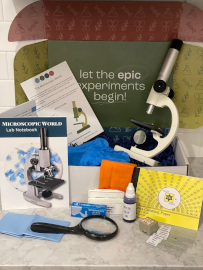BioBox Labs offers monthly science experiment boxes via subscription options from three months to one year, as well as one with no time requirement. The boxes include everything you need, sometimes including preserved specimens for dissections. In addition, most boxes have an online video that demonstrates what students will do.
The BioBox Labs website says the boxes are for ages six and up. While six-year-olds can participate in most activities and discussions, they might find some of the vocabulary as well as the writing beyond them. I think the ideal audience is probably about ages eight through fourteen. Many activities are even suitable for high school students.
New subscribers receive The Microscopic World box as the first box in their subscription because the microscope will be used for experiments in many other boxes. This box includes a basic microscope along with a booklet with step-by-step instructions for several experiments that teach students how to use it. (Students will draw and write in the booklet.) The online video for this box demonstrates how to use the microscope.
New boxes are created each year. Every box includes resources and instructions for three to five experiments. Topics for 2023 boxes announced thus far are fermentation, the eye, germs, plants and water, and arthropods. You can get an idea of the topics covered by previous boxes by checking out their companion videos, viewable on the publisher’s website. For example, there are dissection videos for owl pellets, a sheep heart, a sheep eye, and a clam and an earthworm. Other videos for previous boxes address topics such as “DNA Extraction” and "Why Do We Have Tooth Decay?”.(The publisher tells me that about one-fourth of the boxes involve dissections.)
The subscription model for BioBox Labs means you don’t get to choose your topics, although all relate to biology. The surprise of waiting until a box arrives might be just fine for many families. Others might want to look at upcoming box titles and try to correlate those with other biology lessons. Most kits appear to be viable for months (at least) before they need to be used, so you can adjust your schedule by swapping the order in which you use boxes once the microscope box has been completed.
My Review of the Heart Box
For this review, I received the box titled, “The Heart: The Beat Goes On.” This kit includes a 29-page booklet, a preserved sheep heart, dissecting tools, alcohol wipes, a foam tray to work on, a prepared slide with cardiac tissue, gloves, a nurse’s stethoscope (fully functional—not a toy), and a bag for disposing of the heart.
The video for the box demonstrates the heart dissection. Other activities in the booklet involve studying the prepared slide with a microscope and performing several experiments with the stethoscope.
The booklet has thorough instructions plus space for answering questions (e.g., those about the dissection and the process by which blood flows through the heart), drawing images of the microscope observations, and recording results from stethoscope experiments. Appearing in various formats, the questions are sometimes fairly advanced, such as, “Of all the cells in your body, cardiac cells have the highest number of mitochondria, which are responsible for supplying energy for the cell. Why is this so?” So use your judgment in presenting questions to young students.
Using One Box with Two Students
I think it is possible to use one box with two students. In a family, this might mean that an older student does the more difficult work, such as using the scalpel for a dissection, while a younger student observes. Young students might discuss, draw, and provide oral responses while older students are required to do careful data recording and provide written responses. There is space for only one student to write in a booklet, but additional children can write responses, record information, or draw on their own paper if need be.
Summary
BioBox Labs offer homeschoolers opportunities for guided labs, often with sophisticated resources. And getting a surprise box each month is likely to be a positive motivator.








